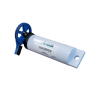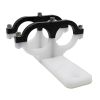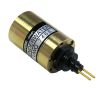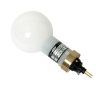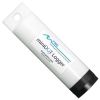PME miniPAR Logger
Features
- Submersible up to 100 meters
- PAR, orientation, and temperature sensors
- Anti-fouling wiper available
- Expedited repair and warranty service
- Lifetime technical support
- More
Overview
The PME minPAR contains a tilt sensor to ensure proper orientation and a temperature sensor. Data is recorded on an internal SD card. The miniPAR is powered by 2 AA batteries and can be fitted with an anti-fouling miniWIPER to protect long-term data accuracy.
Measuring Photosynthetically Active Radiation
The miniPAR is fitted with an LI-192 Underwater Quantum Sensor manufactured by LI-COR. The sensor uses a silicon photodiode and glass optical filters to create a uniform sensitivity to light wavelengths in the 400-700nm range. It measures PAR from all angles in one hemisphere. PAR is a key indicator for understanding nutrient loading, photosynthesis, algae blooms, or other biological, chemical, or physical processes.
Battery Powered
PME is confident that the logger can continue collecting measurements for over one year before the batteries need to be replaced at a sampling interval of one minute. The miniPAR is constructed from strong Delrin plastic that does not easily crack or break.
Embedded Tilt Sensor
The miniPAR is unique among similar loggers in that it contains a tilt sensor to measure the orientation of the device. Since PAR measurement accuracy is dependent upon the sensor being pointed toward the water surface, the tilt sensor will alert the user if the sensor is rotated in a particular direction.
PME Software Included
PME software is provided with every miniPAR logger and can be found on the included SD card when it is connected to a computer. The software creates visual plots to read PAR measurements easily and allows the user to set the internal clock and sample rate.
In The News
Thin Ice: Year-Long Monitoring in Missouri Reservoirs
The value of multi-lake studies is well understood by international organizations like the Global Lake Ecological Observatory Network (GLEON) and the scientists who work tirelessly to provide data to the larger network. Rebecca North, an associate professor at the University of Missouri-Columbia , is one of many researchers involved in multi-lake research initiatives and conducting research locally in her home state. Having been born and raised on the shore of Lake Ontario, North grew up in a community that revolved around water. She also saw firsthand one of the worst water quality bodies of the world, the Bay of Quinte, decline throughout her lifetime.
Read MoreThree Decades of Research at Acton Lake
A multi-disciplinary team at Miami University, Ohio, has been studying the environmental change at Acton Lake for over three decades. Using three different NexSens buoys over this time, the team has an incredible archive of data that is helping build a picture of Acton’s past, present, and future. Until recently, a NexSens CB-50 buoy was used alongside other environmental monitoring at Acton Lake. In May 2025, the Miami team deployed a new XB-200 buoy , future-proofing their ongoing monitoring using real-time buoy systems. Acton Lake, a small hypereutrophic reservoir in southwest Ohio, covers 2.4km² and has a maximum depth of about 8m. The dam was built in 1956, and the lake has a large agricultural watershed.
Read MoreSource Water Monitoring in Albany, New York: Tracing Water Quality throughout Tributaries
Thousands of US cities pull their drinking water from natural source waters like reservoirs, rivers, and streams, making overall watershed health a key consideration for water providers. In Albany, New York, the Albany Department of Water and Water Supply delivers drinking water to over 100,000 residents as well as monitors and manages the larger drinking water supply watershed. Hannah Doherty, Environmental Specialist at the Albany Department of Water and Water Supply , spends her days working with a small team to monitor the drinking supply and the connected water bodies. Doherty explains, “We’re the first to encounter the water that ends up being the drinking water.
Read More







